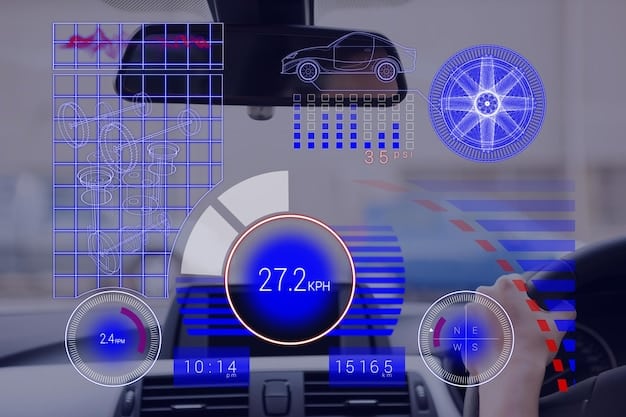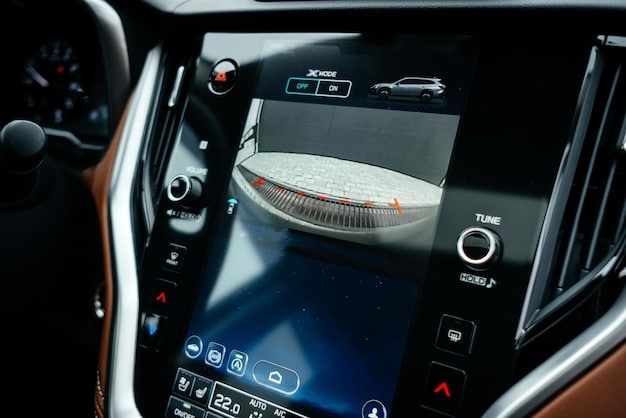Key ADAS Trends Shaping the Future of US Vehicles

Key trends in the development of Advanced Driver-Assistance Systems (ADAS) in US vehicles include enhanced sensor technology, increased data integration, improved cybersecurity, and a focus on user experience and over-the-air (OTA) updates for continuous improvement.
The automotive industry in the US is undergoing a significant transformation, driven by advancements in Advanced Driver-Assistance Systems (ADAS). These systems are not just about adding convenience; they’re fundamentally reshaping how we interact with our vehicles and the road.
Navigating the ADAS Landscape in US Vehicles
Advanced Driver-Assistance Systems (ADAS) are revolutionizing the driving experience in the United States, enhancing safety and convenience for drivers and passengers alike. As technology continues to evolve, it’s essential to understand the key trends shaping the development and adoption of these systems in US vehicles. Let’s delve into the rapidly changing world of ADAS and explore the innovations driving its progress.
The evolution of ADAS is not just about adding new features; it’s about creating a more seamless and intuitive driving experience. The integration of these systems is becoming increasingly sophisticated, with a focus on data fusion, sensor redundancy, and real-time analytics.
Enhanced Sensor Technologies
One of the primary drivers of ADAS advancements is the continuous improvement in sensors. These sensors are the eyes and ears of ADAS, providing critical data for decision-making.
- Radar Systems: Enhancements in radar technology enable vehicles to detect objects at greater distances and with higher accuracy, even in adverse weather conditions.
- LiDAR (Light Detection and Ranging): LiDAR provides precise 3D mapping of the vehicle’s surroundings, essential for autonomous driving capabilities.
- Camera Systems: High-resolution cameras, often supplemented by infrared and thermal imaging, enhance the detection of pedestrians, cyclists, and other vulnerable road users.
These sensor technologies are becoming more affordable and compact, facilitating their integration into a wider range of vehicle models. Furthermore, sensor fusion techniques are improving the reliability and robustness of ADAS by combining data from multiple sensors.

Data Integration and Processing
The proliferation of ADAS features is leading to an exponential increase in the amount of data generated by vehicles. Processing this data in real-time is crucial for enabling effective decision-making and ensuring the safety of ADAS functions. Let’s examine advancements in data integration and processing that are central to ADAS development.
ADAS relies on complex algorithms to analyze data from various sensors and make informed decisions. The integration of this data is becoming increasingly sophisticated, with a focus on sensor fusion, real-time processing, and edge computing.
Real-Time Analytics
ADAS systems require real-time analytics capabilities to interpret sensor data and make split-second decisions.
- Edge Computing: Processing data at the edge of the network, within the vehicle itself, reduces latency and improves the responsiveness of ADAS features.
- AI and Machine Learning: Artificial intelligence (AI) and machine learning algorithms enable ADAS to adapt to changing conditions and improve over time, enhancing their accuracy and reliability.
- Data Fusion: Combining data from multiple sensors, such as radar, LiDAR, and cameras, provides a more comprehensive understanding of the vehicle’s surroundings.
The use of AI and machine learning is enabling ADAS to learn from real-world driving data, improving their performance and reliability over time. This continuous learning process is essential for achieving higher levels of automation.
Cybersecurity in ADAS
As vehicles become more connected and reliant on software-driven systems, cybersecurity is a paramount concern for ADAS development. Protecting these systems from cyber threats is essential to ensure the safety and security of drivers and passengers. Let’s consider the significance of cybersecurity in the context of ADAS.
Cybersecurity is a critical component of ADAS, as these systems are increasingly vulnerable to hacking and cyberattacks. Safeguarding ADAS from unauthorized access and manipulation is essential.
Cybersecurity Measures
Automakers are implementing various cybersecurity measures to protect ADAS from potential threats.
- Encryption: Encrypting data transmitted between vehicle systems prevents unauthorized access and tampering.
- Intrusion Detection Systems: These systems monitor vehicle networks for malicious activity and alert drivers and automakers to potential security breaches.
- Secure Over-the-Air (OTA) Updates: OTA updates enable automakers to remotely patch security vulnerabilities and improve the security of ADAS systems.
Collaboration between automakers, cybersecurity experts, and regulatory agencies is crucial to develop and implement effective cybersecurity standards for ADAS.

User Experience and Acceptance
For ADAS to be widely adopted, it must not only be effective and reliable but also user-friendly and intuitive. Automakers are prioritizing user experience to ensure that drivers can easily understand and interact with ADAS features. Making ADAS appealing and easy to use is essential for fostering acceptance among drivers.
The user interface (UI) and user experience (UX) of ADAS are critical factors in their adoption and acceptance. Drivers need to be able to understand and trust these systems.
Driver-Centric Design
Automakers are focusing on designing ADAS features with the driver in mind.
- Intuitive Interfaces: Clear and concise displays provide drivers with essential information without overwhelming them.
- Customizable Settings: Allowing drivers to adjust the sensitivity and behavior of ADAS features enables them to tailor the systems to their preferences.
- Driver Monitoring Systems: These systems monitor the driver’s attention and alertness, providing warnings if they become distracted or drowsy.
Effective communication and training are essential to ensure that drivers understand the capabilities and limitations of ADAS, promoting safe and responsible use.
Over-the-Air (OTA) Updates and Continuous Improvement
Over-the-Air (OTA) updates are transforming how ADAS are maintained and improved. These updates enable automakers to remotely deploy new features, fix bugs, and enhance the performance of ADAS without requiring drivers to visit a service center. Let’s explore the role of OTA updates in ensuring ADAS stay up-to-date and effective.
OTA updates are becoming increasingly common in ADAS, enabling automakers to continuously improve and update these systems without requiring physical visits to service centers.
Benefits of OTA Updates
OTA updates offer several benefits for ADAS.
- Feature Enhancements: Automakers can add new features and improve existing ones remotely, keeping ADAS up-to-date with the latest technology.
- Bug Fixes: OTA updates enable automakers to quickly address and fix software bugs, enhancing the reliability and safety of ADAS.
- Security Patches: OTA updates allow automakers to deploy security patches to protect ADAS from cyber threats, ensuring the security of vehicle systems.
OTA updates are not only convenient for drivers but also enable automakers to continuously improve the performance and safety of ADAS throughout the vehicle’s lifespan.
Regulation and Standardization
As ADAS technology advances, regulatory agencies and industry organizations are working to develop standards and guidelines to ensure the safety and reliability of these systems. Standardization is essential for promoting interoperability and ensuring consistency across different vehicle models and manufacturers. Regulations play a crucial role in shaping the deployment and use of ADAS technology.
Regulatory agencies and industry organizations are working to develop standards and guidelines for ADAS to ensure safety and reliability.
Key Regulatory Considerations
Several regulatory considerations are shaping the development of ADAS.
- Performance Standards: Establishing minimum performance standards for ADAS features ensures that they meet safety requirements and perform as expected.
- Testing and Validation: Requiring rigorous testing and validation of ADAS systems ensures that they function correctly in various driving scenarios.
- Data Privacy: Addressing data privacy concerns related to the collection and use of data by ADAS systems is essential to protect consumer rights.
Collaboration between regulatory agencies, automakers, and technology providers is crucial to develop effective and consistent regulations for ADAS.
| Key Aspect | Brief Description |
|---|---|
| 🚗 Sensors | Advancements in radar, LiDAR, and camera systems improve detection and accuracy. |
| 🧠 Data Processing | Real-time analytics and AI-driven systems enhance decision-making. |
| 🛡️ Cybersecurity | Encryption and intrusion detection systems protect ADAS from cyber threats. |
| 🔄 OTA Updates | Continuous improvements via remote software updates. |
Frequently Asked Questions About ADAS
▼
Common ADAS features include adaptive cruise control, lane departure warning, automatic emergency braking, blind-spot monitoring, and parking assist. These technologies enhance driver awareness and safety.
▼
ADAS improve safety by providing drivers with real-time alerts, assisting with vehicle control, and mitigating potential collisions. These systems help reduce accidents and injuries on the road.
▼
AI plays a critical role in ADAS by enabling advanced data processing, object recognition, and decision-making. AI algorithms help ADAS adapt to changing conditions and improve performance.
▼
Yes, ADAS systems can be vulnerable to cyberattacks. Automakers are implementing cybersecurity measures, such as encryption and intrusion detection systems, to protect ADAS from potential threats.
▼
ADAS systems can receive updates over-the-air (OTA) to enhance features, fix bugs, and improve security. The frequency of updates depends on the automaker and the specific ADAS technology.
Conclusion
The development of Advanced Driver-Assistance Systems (ADAS) in US vehicles is shaped by continuous advancements in sensors, data integration, cybersecurity, user experience and regulatory standards. These trends are paving the way for safer, more convenient, and more connected driving experiences, promising a future where vehicles can proactively assist drivers and mitigate risks on the road.





